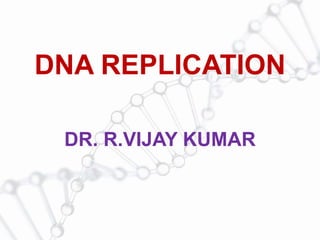
Dna replication
- 1. DNA REPLICATION DR. R.VIJAY KUMAR
- 2. DNA - Genetic Material • Experiments on bacterial transformation by Frederick Griffith (1928)- S. pneumoniae • Type-III (S)---virulent, type-II (R) strains--- nonvirulent
- 3. Transforming principle • Avery, Mac Leod and Mc Carty- D. pnuomoniae • Identified chemical nature of the transforming principle. • They get the cultures of as S strain, an extract of lysed cells. • After all its proteins, lipids and polysaccharides had been removed, the extract still remained the transformation capacity from R to S. • Purified each component….finally concluded DNA
- 5. Blender experiment- Hershy and Chase • Grew bacteria and T2 phages in a culture containing S35 metheonine which was incorporated into protein. • Second set T2 phage were labeled with p32 which is the component of DNA and DNA was labeled. • The radioactive tags of the phage thus provide a facility to track them upon infection to ulabelled bacterial cells. • After inoculation the cells were agitated to remove ghosts attached to the cell wall of the bacteria. • Culture was centrifuged to separate heavier bacterial cells as pellet and lighter phage ghosts as supernatant. • Most P32 (DNA) found in pellet, most S35 (protein) in supernatant. • Confirms substances injected to the bacteria by the phage is DNA
- 8. DNA REPLICATION • 1. Semi conservative replication- Meselson, Stahl- ----- one parental and one daughter. • 2. Conservative Replication- both parental strands received by one cell, while new daughter strands synthesized denovo are passed to another cell. • 3. Dispersive replication-fragments of parental and daughter DNA are dispersed in both strands.
- 9. Meselson and Stahl’s experiment • Bacterial cells grown several generations under media- N15. (DNA with heavy N15). • Then these cells were transferred into the new media containing normal N14. • After several generations all bacteria were collected and DNA of these were extracted and dissolved in a solution having CsCl and allowed for rapid centrifugation, which causes concentration gradient. • This results the movement of DNA molecules to move according to its density equals with Cs. • DNA with N14 positioned at top, DNA with N15 densier at lower of test tube, after single generation the bacteria possesses both N- 15and N14 and positioned at center of tube (in N14 media). • After 2 generations in N14 media, 2 bands were obtained- one will be mediate density (N15 and N14 DNA), one of the low density containing N14 (upper).
- 12. DNA – REPLICATION- PROKARYOTES • COMPONENTS- 1. DEOXYRIBONUCLEOTIDES-dNTPS – (dATP, dCTP, dGTP, dTTP). 2. ENZYMES- • Helicase • Topoisomerase • DNA polymerase • RNA polymerase • DNA ligase • RNase H 3. PROTEINS • replication initiator proteins –Dna A,B, C- openin of DNA at Ori C • Single standerd proteins – SSBPs bind to single strands of DNA and prevent reannealing. • Sliding clamp proteins-protein of the DNA polymerase, tethers to DNA and avoids frequent dissociation from DNA
- 13. MECHANISM 1. ORIGIN OF REPLICATION- In E.Coli- at Ori C (245 p, 13 mer- 13 bp.repeats and four 9 bp called 9mer). Dna Abinds to 9 mer and promotes the opening of DNA in the 13 mer segment, other Dna B and C also bind at 13 mer and denatures locally and separate two stands 2. DNA TEMPLATE FORMATION- DNA helicase unwinds double strand, Toposiomerase avoids supercoiling SSBPs prevents reannealing 3. REPLICATION FORK 4. RNA PRIMER FORMATION 2 primers are formed one- in the template 3’ to 5’ polarity 5’to3’ polarity will have several primers with the gap 1000-2000 nucleotides. at one end of the RNA primer is a terminal nucleotide with 3’OH group onto which DNA polymerase –III adds new deoxyribonucleotides, using SSDNA as a template. The first dNTP exposed a 3’OH group, onto which another dNTP is added.
- 14. • 5. ELONGATION DNA polymerase III continuously adds 3’OH groups as long as the DNA template is available by phosphodiester bonds. New nucleotide always added at 3’ So synthesis proceeds from 5’to 3’ a) Leading strand- 5’ to 3’ direction, it synthesizes continuously, towards replication fork. b) Lagging strand- newly added nucleotides have 3’OH group facing away from replication fork (5’ to 3’) newly exposed SSDNA on upper template cannot be used as template for replication until new primer is added, because the previous primer has 5’ phosphate group facing replication fork. So this synthesizes discontinuously. c) Okazaki fragments-upper template synthesizes lagging strand, fragment size is approximately 1000-2000 nucleotides long- okazaki fragments. Each okazaki fragment is initiated at RNA primer (by Primase) and extended by DNA polymerase III, primers removed by DNA polymerase I.
- 17. E. Coli- DNA polymerase III-------alpha subunit I-leading strand Alpha subunit – II –lagging strand 2 beta subunits guide this process. DNA polymerase has 3’to 5’ exonuclease activity also to remove mismatched nucleotides. DNA polymerase will aslo assist in proof reading DNA polymerase II is for DNA repair DNA ligase seals the gap in the growing strand • 6. TERMINATION- Two replication forks proceed in opposite direction and meet at 180’, once replication is completed 2 daughter circles remain interlinked. They are delinked by topoisomerase IV.
- 18. DNA REPLICATION- EUKARYOTES • Mostly general mechanism • DNA of eukaryotes has wrapped by histones and non histone proteins- nucleosomes • DNA polymerases- • 5 • DNA polymerases-αβδεϒ • Lagging strand-α • Leading strand-δ • Reparing-ε, β • Proof reading-ϒ
- 20. Thank you